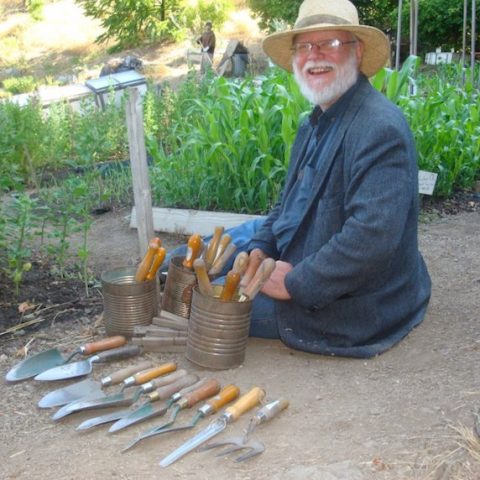Biointensive gardening is the buzzword in gardening these days and for good reason.
If you could grow 2-6 times more produce on less land and use less water, wouldn’t you want to? That’s a no-brainer, obvious “YES”, right? With the practical biointensive process, you can repair soil, increase yield, and save water and money.
But what is it?
Biodynamic gardening It’s an ancient practice made new again.
What is Biointensive Gardening?
Have you noticed how things come and go in cycles? It makes sense. That’s nature and it’s just the nature of the spiral of life and growth, where we encounter similar experiences, but on a different turn of the spiral journey through seasons and through experiences. Biointensive gardening is one of those things.
There are many societal challenges today, and we’re making mistakes that show we haven’t yet — as a civilization — learned the lessons of history, such as the fall of Rome. However, there are things we are bringing forth from the past that are good, and biointensive gardening is one of those.

Biointensive gardening is an ancient practice made new again.

The Origins of Biointensive Gardening — Biodynamic Weds French Intensive
The origins of Biointensive Gardening trace back to the ancient Chinese, Greeks, Mayans, and of the Early Modern period in Europe, as well as in West Africa, from at least the late 18th century.[1]https://en.wikipedia.org/wiki/Biointensive_agriculture
English Master Gardener, Alan Chadwick, (July 27, 1909 – May 25, 1980), brought together the biodynamic and French intensive gardening methods, as well as his own unique approach, to form what he called the Biodynamic-French Intensive method. Today this is most often shortened to “biointensive”.
The method was further developed by John Jeavons and Ecology Action,[2]https://www.growbiointensive.org/into a sustainable 8-step food-raising method officially known as “GROW BIOINTENSIVE® Sustainable Mini-Farming”.[3]https://en.wikipedia.org/wiki/Biointensive_agriculture
Now is the Time
There is much need today, as well as much interest in becoming more self sufficient—and healthier—by growing more of our own food.
The timing is excellent for the reintroduction and proliferation of biointensive gardening.

Image and information excerpted from JohnJevons.info,[4]https://www.johnjeavons.info/index.html and GrowBiointensive.org.[5]https://www.growbiointensive.org/
Next: The good news in commercial farming and gardens.
Biointensive Commercial Gardening
The good news is that substantial efforts are being made to integrate biointensive and organic gardening techniques into commercial farming and gardens. Steps are being taken increasingly, to develop organic agricultural systems that consider health benefits to the earth and humanity.
Well thank goodness. It’s about time! Now let’s dig deeper into biointensive gardening techniques.
Biointensive gardening is a form of organic gardening that rebuilds and maintains soil fertility through nutrient cycling.
Commercially Viable
So biointensive gardening isn’t just for home gardens. It’s a commercially viable technique, which aims at diversified cropping and bio-bed preparation on small plots of land, with maximum yield.
Biointensive involves harvesting a diverse range of crop varieties, that are less susceptible to pest outbreaks. This process also has monetary gains, as it preserves indigenous seed varieties and has a good crop sale value, as a result of being completely organic.
We love this image from the Grow Biointensive organization that showcases productive gardening on a hillside. A good portion of our property is in the woods and another portion is on a big hill, so this is definitely something we’re studying and planning to build in the future.

The Biointensive Plan
A sustainable layout can be implemented in your backyard garden, within a limited amount of space. Firstly, you need to focus on the various methodologies of this farming technique, and some organic gardening tips.
A Biointensive Garden Plan Should Include:
- Raised Beds – Double Dug (24″), if the soil needs it. (See video on double digging garden beds).
- Composting
- Companion Planting
- Intensive Planting
- Carbon Farming – see biochar soil amendment
- Open Pollinated Seeds
- Calorie Farming, such as high protein plants
- Rotational Cropping
- Whole-System Farming Method

Repair Soil and Increase Crop Yields by 2-6 Times More Production
John Jevons, the author of How to Grow More Vegetables, shows us how you can get 2-6 times more produce while using less water in his video series beginning with the first one here.
The Biointensive method can actually repair soil and use a fraction of the water of traditional methods.
“While the farmer holds the title to the land, actually it belongs to all the people because civilization itself rests upon the soil.”
Thomas Jefferson
SESSION 1: Introduction to Biointensive Gardening
This is the first episode in a series from the author of the sustainable gardening classic, How to Grow More Vegetables. The whole series is available as a full-length uncut DVD, and more episodes are being posted online at JohnJeavons.com.
With this revolutionary organic gardening method, you will learn to grow more food in less space, to build truly sustainable soil fertility, and to save money by reducing water, energy and fertilizer use! This self-teaching series provides an excellent introduction to the GROW BIOINTENSIVE method and will have you out implementing it in the garden in just a few sessions!
Topics include garden bed and soil, seedlings, transplanting, composting, harvesting, saving seeds, choosing your crops, and maintaining your garden.
If you’re interested in biointensive gardening, then you’ll enjoy this permaculture documentary on one young couple’s journey from the city and deep into biodynamic farming and gardening.
SESSION 2: Growing Seedlings
SESSION 3: Double Digging, Weeding
The hallmark of double digging is to dig 24 inches down.
Traditional garden depth is 6 inches. Biointensive garden depth is 24″.
For videos 4-8 in this GrowBiointensive.org series, continue playing the rest of the videos on YouTube, or visit John Jevons’ GrowBiointensive.org YouTube channel.[6]https://www.youtube.com/user/JohnJeavonsGrowBio/videos?nohtml5=False
“What saves a man is to take a step. And then to take another step.”
~CS Lewis, British author, professor, lay theologian, 1898-1963
Cover image from GrowBioIntensive.org’s Facebook Page.[7]https://www.facebook.com/EcologyActionoftheMidPenninsula/photos/pb.103720706390652.-2207520000.1460478430./326689847427069/?type=3&theater

We are an online gardening publication sharing all things garden related! Including urban farming, family gardening, homesteading, gardening for profits, and more. We’re all about growth!
References

